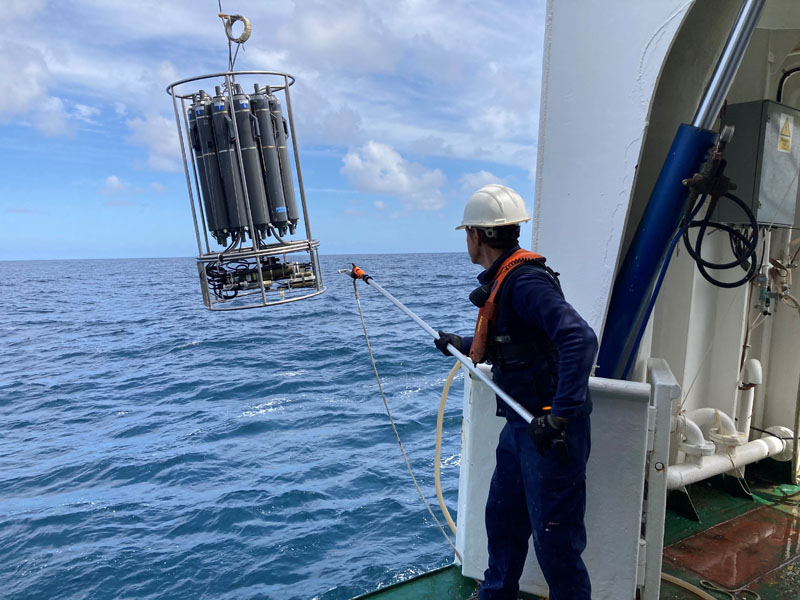DNA from a bucket of water key to improved marine environmental management
Últimas noticias
AZTI Researcher Ángel Borja Receives Prestigious Odum Award for International Scientific Career
Una mirada LGTBIQ+ al reino animal
Circular Economy in Action: Valorisation of By-products through Projects like PRIMA NEWFEED
- The AZTI technological centre has studied the potential of environmental DNA sequencing to monitor marine resources more economically and accurately than with commonly used methodologies.
- Research has focused on the analysis of ocean water samples and has found that environmental DNA sequencing can, more accurately than traditional methodologies, determine the abundance, diversity and spatial distribution of fish and elasmobranchs, which can contribute to improving monitoring programs for commercial fisheries and, especially, for deep ocean species, inaccessible with traditional techniques.
- The study is part of the EDAMAME project, a project funded by the State Research Agency (AEI) of the Ministry of Science and Innovation and the European Regional Development Fund (ERDF).
Sukarrieta, 31 March 2022.- The sequencing of marine environmental DNA -that DNA present in the water in the form of cells, tissues or mucous detached from the organisms that inhabit a certain aquatic environment- offers economic and precision advantages when measuring the biodiversity of ecosystems with respect to more traditional methodologies.
In this context, the AZTI technological centre, specialized in the marine and food value chain, has worked within the framework of the EDAMAME project to study the potential of environmental DNA sequencing to analyse the diversity, abundance and distribution of fish and elasmobranchs in the Bay of Biscay.
The results of this research will especially help regional, national and international agencies in charge of monitoring the marine environment, as they will have access to a more cost-effective methodology to assess the marine environment and develop efficient management policies.
“Environmental DNA allows, by sampling a few litres of water, to study the biodiversity of an entire body of water and, based on the estimates obtained, to develop and evaluate indicators that will be integrated into environmental and resource assessment programs,” explains Naiara Rodríguez-Ezpeleta, head of the project.

Índice de contenidos
Abundance, diversity and spatial distribution
To develop this methodology, within the framework of the BIOMAN oceanographic monitoring campaign, and from an ecosystem approach, the AZTI research team carried out multiple samplings and compared the fish diversity results obtained through environmental DNA sampling with the estimates generated through pelagic fisheries.
Forty-four 5 L samples of surface water in the Bay of Biscay were collected and filtered. These filtrates were sequenced and, after comparing the nearly 3.5 million environmental DNA reads obtained with a reference database, nearly a hundred more species were found than those caught by fishing nets in the same spots.
“We now know that the genetic analysis of a few litres of water gives an estimate closer to the reality of the species present in an area of the ocean than the fishing of hundreds of kilograms of fish,” says the AZTI expert.
In addition, the research team has determined that eDNA is also an indicator of abundance, since the species detected with both methods had a correlation between the biomass in the fisheries and the number of water eDNA reads; it has also been observed that environmental DNA is distributed according to the spatial distribution of species.
“Thanks to these results we can ensure that through environmental DNA we are able to draw solid ecological conclusions that can contribute to fisheries monitoring programs,” adds Rodríguez-Ezpeleta.
Towards deep ocean sustainability
On the other hand, environmental DNA samples of deep ocean water were analyzed, which has provided greater knowledge about this inaccessible ecosystem and has allowed progress towards establishing the basis for a sustainable use of the resources of this environment.
Specifically, the AZTI team has analysed the environmental DNA of water samples from up to 2,000 metres deep in the Bay of Biscay.
The study has verified for the first time that eDNA is vertically distributed according to the depth at which the species it belongs to are usually found.
“The richness and abundance of deep-sea fishes according to their environmental DNA increases with depth. In addition, it also shows diel community patterns and species-specific vertical distributions that coincide with the known migratory behavior of many of these fishes,” observes the AZTI researcher.
Thus, the study concludes that the environmental DNA of epipelagic species, those found less than 200 meters from the surface and usually caught with pelagic fishing nets (such as anchovy, sardine or mackerel) is predominant at the surface, while the environmental DNA of deep-water species (such as monkfish, bottom anchovy or glacial lanternfish) is mostly found further to the bottom.
These findings highlight the potential of environmental DNA to improve knowledge about fish species inhabiting the dark ocean and thus move towards sustainability and conservation of an environment that provides vital global functions, such as sequestering carbon from the atmosphere.
Developed between January 2018 and September 2021, the EDAMAME project has been led by AZTI and has been funded by the State Research Agency (AEI) of the Spanish Ministry of Science and Innovation and the European Regional Development Fund (ERDF).
References:
- Fraija-Fernandez N, Bouquieaux MC, Rey A, Mendibil I, Cotano U, Irigoien X, Santos M, Rodriguez-Ezpeleta N (2020). Marine water environmental DNA provides a comprehensive fish diversity assessment and reveals spatial patterns in a large oceanic area. Ecology and Evolution 10: 7560-7584 (10.1002/ece3.6482)
- Canals O, Mendibil I, Santos M, Irigoien X, Rodríguez-Ezpeleta N (2021). Vertical stratification of environmental DNA in the open ocean captures ecological patterns and behavior of deep-sea fishes. Limnology and Oceanography Letters. 6: 339-347 (10.1002/lol2.10213)







